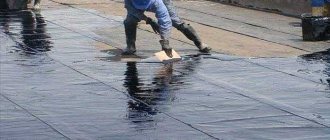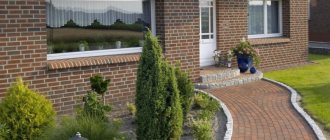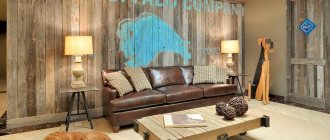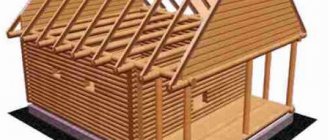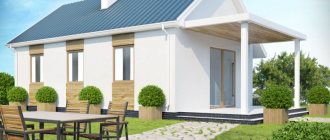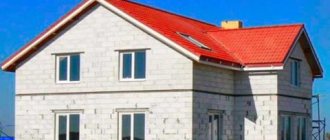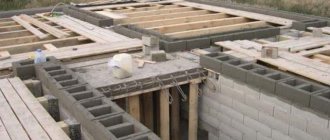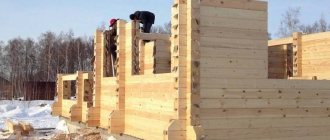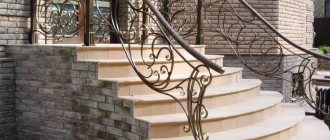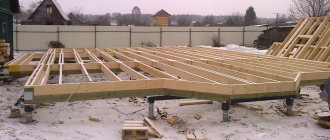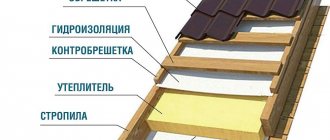A huge range of roofing materials for the roof of a country house often creates problems for inexperienced developers. They do not fully understand what factors to focus on and what affects the performance of materials. The roof performs not only a protective function, its significance is much broader. Mistakes during selection can create significant problems in the future.
Types of roofing for the roof of a private house
Types of roofing for different types of roof
The parameters of the rafter system have a significant impact on the choice of roofing; there are several factors that must be taken into account; this is the only way to guarantee a high-quality and durable roofing for the house.
Flat roofs
The angle of inclination of the slopes is no more than 12°. Such roofs are used during the construction of large country cottages; they can be used or ordinary.
Flat metal roofing
On the exploited flat roofs there are winter gardens, areas for active recreation or walking.
Flat roof and pool
There are options for arranging car parks on flat roofs. To create usable flat roofs, you should buy the most durable and reliable roll coverings or mastics. Currently it is a polyester-based euroroofing material.
Euroroofing material
This material has the highest strength indicators and a service life of at least fifty years. Modified bitumen is used as waterproofing, which does not lose its plasticity at low temperatures. On polyester roofs you can install heavy structures, make durable reinforced concrete screeds, etc.
Laying euroroofing felt
The second material for sealing flat roofs is liquid mastics. There is a wide choice in sales; in terms of their technical characteristics, mastics fully meet existing requirements.
Mastic roofing
Pitched roofs
The number of slopes is from one to 5–8, it all depends on the complexity of the rafter system and the architectural features of the structure. On pitched roofs, you can use any type of roofing materials: soft and hard, rolled and piece, profiled and flat, modern and traditional.
Multi-pitched tile roof
Each type has its own characteristics and is selected taking into account operating conditions, the selected design project and the financial capabilities of the consumer. The cost of some types of roofing can be very significant, and most developers cannot afford them.
Roof of complex configuration
Slate roofing
This type of roofing material for roofs, like slate, has been very popular for a long time. It is made from a mixture based on asbestos and cement. Sometimes slate is painted in different colors to match the color of the house, but most often it is used in its original form, that is, in gray.
Slate sheet sizes
Advantages of asbestos-cement slate:
- Strength;
- Does not warm up in the sun;
- Does not conduct electricity;
- Good maintainability;
- Non-flammable;
- Not susceptible to corrosion.
Photo of slate replacement
The disadvantages of slate roofing include:
- Fragility of building materials;
- Heavy weight;
- Ability to absorb rain and melt water.
As for the cost, it is quite low - from 150 rubles for a standard sheet.
General characteristics of roofing materials
Regardless of the specific features and technical characteristics, all roofing materials have common evaluation criteria.
- Maximum total loads . They must withstand snow cover, gusts of wind, and the weight of builders.
- Operating parameters. These include durability, ease of installation and maintenance, and original design solutions.
- Price. You should take into account not only the price of the material itself, but also additional elements, special units of the rafter system, requirements for sheathing, and other conditions. In addition, the complexity of the installation has a significant impact; the amount of remuneration for roofers depends on it.
The more complex the roof, the more expensive its construction will be.
Due to the fact that the roof is constantly exposed to numerous negative factors, it must be resistant to mechanical loads, deformations, severe exposure to ultraviolet rays, and large temperature changes. At the same time, maintain the tightness and presentable appearance of the roof for a long period of time, do not require much time for maintenance, and be repairable and replaceable.
Important factors are the durability and maintainability of the roof
Roll fused roofing
Multilayer guide roll material is made from fiberglass, polymers or bitumen.
Its advantages:
- High strength, which reduces the likelihood of tearing during installation;
- Good vapor permeability;
- Ease;
- Environmental friendliness;
- Variety of designs;
- Possibility of sealing seams by heat welding.
Rolls
The disadvantages of this roofing option for the roofs of private houses include:
- Not very attractive appearance;
- Low fire resistance;
- Possibility of sliding at large angles of inclination (30 degrees or more).
The price of such roofing material is small - from 350 rubles per roll of 9 m².
What are the most popular types of roofing for a home?
There is no clear and universal advice on choosing the type of roof; each of them has its own strengths and weaknesses; many factors should be taken into account when choosing. Moreover, not all of them are objective, caused by the operating conditions of the building. Many are purely subjective; outside advisers cannot influence the choice; the final decision is made only by the consumer, taking into account his personal preferences.
Metal tiles
Today, the most used material for roofing buildings for various purposes. It is made from thin sheet metal and has several layers of corrosion protection. A profile with interchangeable dimensions is formed using special equipment. The outer coating is especially durable polymer paints of various colors. The warranty is 5–15 years, in practice it is used for up to 30 years. It can have a glossy or matte front surface; glossy ones retain less dust.
Metal tile Supermonterey Polyester
Metal tile Kamea
Metal tiles Ruukki
Disadvantages - on complex roofs the amount of waste increases to 15%. There is a high probability of purchasing low-quality coatings due to the difficulty of checking quality by consumers. It is impossible to independently determine the thickness and uniformity of the zinc layer; it is also difficult to determine painting parameters. Another problem is that fire codes require lightning rods to be installed on all metal roofs, which complicates roof installation.
Lightning protection of metal roofing
Prices for metal tiles
Metal tiles
Bitumen (flexible) tiles
It ranks second in popularity after metal coatings. It is made of durable bitumen roofing felt on a polymer base. The waterproofing layer is artificial bitumen modified with innovative additives; new manufacturing technologies increase the plasticity of the material even at low temperatures, increase mechanical strength and resistance to sunlight.
Flexible tiles Katepal Rocky. Terracotta
Flexible tiles Icopal. Antik Green forest
Flexible tiles Katepal Rocky. Autumn leaves
The plasticity of the base and bitumen allows you to easily compensate for minor temperature fluctuations in roof elements. The top layer is covered with stone chips - the appearance improves, resistance to various damage increases, and service life increases.
Flexible tile Katepal Jazzy. Grey
Flexible tiles Tegola Nordland Nordic. Shimmer blue
Shinglas Jazz flexible tiles. Barcelona shade
The roof slope angle must be at least 12°; the material can be used on roofs of complex geometry. Excellent technological characteristics minimize the amount of unproductive waste (no more than 5%).
Roofing made of bituminous tiles
Disadvantages - susceptibility to UV rays; over time, mold and moss appear on the surface, which significantly worsens the appearance of the roof. Due to the fact that the installation technology requires continuous sheathing and does not provide for natural ventilation, during the construction of the rafter system it is necessary to use the most expensive waterproof OSB board, which almost doubles the estimated cost of the roof.
Laying flexible tiles
Prices for various types and manufacturers of flexible tiles
Flexible tiles
Composite polymer sand tiles
A rather complex roofing material from a technological point of view, it is made from sand (up to 70%), polymers (up to 25%) and dyes (up to 5%). Resistant to the negative influences of external factors, able to withstand significant mechanical loads. Weight up to 21 kg, service life up to 50 years, warranty up to 15 years.
Roofing made of polymer sand tiles
The material is not afraid of static and dynamic loads. These indicators significantly exceed those of natural ceramic tiles. It has low thermal conductivity, which reduces the volume of condensate during temperature fluctuations. The absence of pores increases resistance to freezing/thawing; some types can withstand up to 200 cycles.
Piece polymer tiles
Disadvantages - high cost, difficulty of installation, coating is moderately flammable. The main problem is unscrupulous manufacturers. Such companies use recycled polymer, which is obtained after recycling waste. Recycled plastic is significantly inferior in quality to primary plastic; accordingly, the actual performance characteristics of polymer tiles do not meet the declared ones.
Over time, the roof erodes, which means that its thickness may decrease under the influence of negative factors.
Cement tiles
Piece roofing is made from a cement-sand mixture. Various dyes are added to improve the appearance.
Cement-sand tiles
Cement tiles are heavy, which requires special preparation of the rafter system. This is the only roofing material that increases strength over time. Cement mortar reaches its maximum physical strength after a hundred years.
No toxic materials are used during the manufacture of tiles. Therefore, this roofing material is safe and harmless to health.
The roof is durable and withstands loads well, including impact loads. Withstands approximately 50 freeze/thaw cycles and is not afraid of sunlight. Made from quartz sand and cement. Mineral dyes are added to change the color.
Disadvantages: installation is difficult; highly qualified roofers are required.
Installation of tiles
Over time, moss and mold appear on the surface. When purchasing, you should carefully check the uniformity of dimensions; the slightest violation of technology or production on obsolete equipment causes deviations from the geometry. Cement is afraid of acidic environments; therefore, the use of cement tiles for covering houses located in large industrial cities is strictly not recommended.
Installation of cement-sand tiles
Natural tiles
One of the most expensive and difficult to install roofing coverings. Piece material, only the most experienced roofers are allowed for installation. Made from natural clay by pressing and firing. The technology is complex and expensive, requiring a large amount of special industrial equipment and the proximity of a quarry with clay suitable for analysis. The service life is 70 years, but there are many examples of ancient buildings with preserved roof coverings.
Ceramic tiles
Natural tiles are considered an exclusive material, used on prestigious buildings or during the reconstruction of historical buildings. Can be repaired; replacing tiles that have failed for various reasons does not present much difficulty.
Ceramic tile roofing is repairable
The main disadvantage is the high cost. The price is artificially high; the production of the material does not require such large financial investments. The complexity of installation increases the cost of the rafter system by approximately 10–15%; the roof can only be mounted on slopes with a large angle of inclination.
Another drawback is that even minor violations of the installation technology will certainly make themselves felt during the operation of the building. It is difficult to check the quality immediately after completion of the work; you need to lean on the roof.
When laying tiles, it is important to follow the technology
Comparative table of characteristics of different types of tiles
| Parameter | Metal tiles | Flexible tiles | Composite tiles | Cement-sand tiles | Natural tiles |
| Average weight kg/m | 4–6 | 8–11 | 8–9 | 45–55 | 45–55 |
| Noisiness | High | Low | Average | Low | Low |
| Resistance to open fire | Non-flammable | Supports open combustion | Non-flammable | Non-flammable | Non-flammable |
| Warranty period from the manufacturer | 15–20 | 25–30 | 45–50 | 35–40 | 60–80 |
| Average cost, rub. | 850–950 | 1050–1250 | 1250–1500 | 1150–1300 | 1600–1800 |
| Approximate wages for roofers, rub. | 300–400 | 400–600 | 300–500 | 500–650 | 600–800 |
| Approximate roof estimate, rub. | 1150–1350 | 1400–1850 | 1550–2100 | 1650–1950 | 2200–2600 |
Profiled sheets are just as popular as metal tiles.
Prices for different types of tiles
Roof tiles
Technical characteristics of profiled sheets
Technical parameters differ slightly from metal tiles, service life is 15–20 years. The cost is slightly lower than metal tiles, which makes it the cheapest modern roofing material, except for bitumen and slate. But bitumen coatings are very rarely used on pitched roofs of houses. The corrugated sheet has different thickness and profile parameters, the color is classified according to international standards.
Corrugated sheeting as a roofing covering
Disadvantages - the appearance does not meet modern requirements. This drawback is temporary; nowadays manufacturers have learned to make very beautiful profiles with simple geometry. Another problem is high sound conductivity, but this only manifests itself in cases where attic spaces are residential. A lot of noise occurs during heavy rain or hail; such precipitation occurs infrequently in most regions of our country; the noise does not cause much inconvenience.
Metal roofs are noisier
Ondulin
It is made on the basis of cellulose fabric, modified bitumen is used as waterproofing, the color is changed by pigments. It has the appearance of wave slate.
Ondulin
The warranty is 5–10 years depending on the type and manufacturer, but in practice it can last more than 20 years. Resistant to hail impacts, can bend and take the shape of the rafter system. Special coatings inhibit the development of fungi and mold on the surface and do not impair the initial performance characteristics in the temperature range from -40°C to +80°C. Frost resistance of at least 25 cycles, not afraid of chemical compounds. In terms of price, it falls into the category of budget roofing coverings.
Ondulin - budget roofing covering
Disadvantages: the color of the surface changes under the influence of ultraviolet rays, the edges curl up a little. Ondulin burns and requires unconditional compliance with all fire safety rules. In terms of overall quality indicators, it ranks last among all roofing materials.
The roof covering is not very strong and durable
Prices for various types of ondulin
Ondulin
Galvanized steel sheet
Currently used rarely and only in seam roofs. Installed on a continuous sheathing, due to its flexibility it can copy the shape of the roof. It is rarely used on houses; it is recommended for various sheds and outbuildings.
Galvanized seam steel roofing
Disadvantages - the design does not meet the needs of modern developers; continuous sheathing is required for the covering. Low bending strength values exclude the possibility of arranging natural ventilation of the under-roof space. To increase the service life, all wooden elements of the rafter system must be impregnated several times with antiseptics, and if possible, use moisture-resistant boards.
Roofing made of galvanized steel sheets
Prices for galvanized steel sheets
Galvanized steel sheet
Keramoplast
It is made from a special modified polymer with increased parameters of physical strength and resistance to UV rays. To reduce the cost, natural fillers are introduced into the composition; the color depends on coloring additives. A relatively new roofing material, its appearance resembles corrugated slate. It comes in a variety of colors and has a service life of 30 years.
Keramoplast - roofing material
Does not absorb moisture, therefore, is not afraid of freezing/freezing. Plasticity allows you to absorb shock loads; the roof can be used in various climatic zones, except for the Far North. It is easy to cut; there is no need to use special devices and tools during installation. The installation technology is similar to laying ordinary slate.
Installation of ceramoplast roofing
Disadvantages - the high cost does not correspond to the same high performance characteristics. Under the influence of ultraviolet radiation, plastic gradually loses its original properties, becomes brittle and cracks under minor loads. There is no point in repairing the roof; physical aging occurs over the entire roof area. The only way out is to completely replace the roof, which is expensive and time-consuming.
Fastening ceramoplast
Asbestos cement wave slate
Traditional roofing material made from cement and asbestos fillers. It can have a different number of waves; currently it is used only on non-prestigious buildings. In our country, slate is made from safe asbestos, which is not included in the list of carcinogens. Sheets can have a natural color or be painted in various shades. Despite the wide variety of modern roofing materials, traditional slate still occupies a high position in sales today. The guaranteed service life is at least 30 years; in practice, it is used for more than fifty years.
Asbestos cement slate
There are several disadvantages - heavy weight and low mechanical strength. The large weight complicates the installation process and requires special measures to strengthen the rafter system. Slate easily cracks with minor changes in the linearity of the roof, and the covering must be repaired. If there is heavy hail in the region, the roof will have to be completely replaced.
Slate roofing - photo
Varieties of modern sheet roof coverings
Roofing materials
The material is presented for sale in the form of separate sheets of different lengths and widths. Elements are produced flat or profiled in the form of waves. Corrugation comes in square, trapezoidal and semicircular shapes. They are attached to the roof with self-tapping screws and nails. The installation technology is simple and does not require the use of special equipment; hand tools are used.
Sheet building materials provide strength to the roof covering, but some types conduct noise from rain and birds, so an insulating layer is installed. Previously, unpainted black roofing steel was used, but now galvanized steel is installed.
Copper sheets decorate the house as they look beautiful. The material is rarely used due to its high price. Copper is sold in the form of rolled strips 67 cm wide and 06 - 0.8 mm thick. The roof covering is made of zinc (called zinc-titanium), which is an alloy with small additions of titanium and copper for ductility when cooled.
Metal tiles
Metal tiles - covered with a polymer layer to protect against moisture
Made from galvanized steel, which is rolled and stamped to shape into individual tile elements. After this, the sheets are coated with a polymer composition to further protect the roofing from corrosion.
Factories produce strips:
- up to 6 meters long, and made to order up to 8 meters;
- width is 1120 – 1180 mm;
- thickness ranges from 0.35 – 0.6 mm;
- sheet weight is within 4 – 9 kg.
The lightweight material does not require a powerful rafter system or metal trusses; it is mounted on roofs with an inclination angle greater than 15°. The strips are overlapped and overlapped by the width of one wave; self-tapping screws with rubber washer gaskets are used for fastening.
Sheets are selected taking into account the required rigidity. For example, a metal profile with a thickness of 0.035 - 0.4 mm is deformed with little effort. Such sheets are used for temporary roofing and canopies for pavilions. Thin strips are installed in short elements (up to 3 m), increasing the slope of the slopes to 40°.
Asbestos cement slate
Asbestos-cement slate is a cheap material that can be used temporarily for roofing
Refers to cheap coatings, popular at one time, but gradually replaced by new types of coatings. Slate is made from asbestos-cement mortar, which contains 15% asbestos and 85% cement. Sheets are distinguished by geometric dimensions, number of waves and their height.
Parameters of slate elements:
- width 800 – 1130 mm, length 1200 – 1750 mm;
- the sheet weighs 9 – 15 kg;
- There are 6, 7, 8 waves on the panel.
The building material lasts a long time under normal operating conditions, but is fragile and can crack due to mechanical shocks or walking on the roof during repairs.
Slate modifications:
- ordinary corrugated slate - VO, size 800 x 1200 mm, thickness 5.5 mm;
- reinforced profile - VU, size 800 x 1750 and 800 x 2000 mm, thickness 8 mm;
- unified slate - UV, sizes according to type VU and VO.
Used for roof slopes of 12 – 60°, secured to the sheathing with slate nails or using regular hardware with spacers. Most often used for outbuildings and small buildings.
Ondulin
Ondulin is an environmentally friendly material
Produced from cellulose, the raw materials are environmentally friendly. The mass is pressed to give shape and heated in a chamber to +120°C. Externally, the building material resembles slate, but differs from it in characteristics. The dried blanks are impregnated with bitumen and painted with polymer compounds. Ondulin does not get wet and does not conduct water, thanks to special treatment.
Lightweight material saves money when constructing a load-bearing roof frame. A continuous sheathing is placed under the ondulin, chipboards and OSB are used. Its flexibility allows it to be mounted on curved roofs.
Advantages of coverage:
- water resistance;
- hygiene, safety;
- simple installation;
- ease;
- simple cutting and processing;
- noiselessness.
The disadvantages of ondulin include flammability. During hot weather, an unpleasant bitumen odor may appear. When exposed to sunlight, it changes color and sometimes fades.
Seam roofing
Steel strips with folded latches
The material is represented by steel strips with a smooth surface in the form of a roof covering. There are locks on the edges called folds. There are recumbent, single, standing and double types of connecting elements. They produce sheets without coating (galvanized) and with a polymer layer on the surface. Often used for hangar roofs, since the building material has spatial flexibility.
The locks are crimped with special machines to secure the joints. Installation on slopes is carried out in parts. A map is made on the ground from several flat elements, joined along the length with standing seams, and along the width with lying folds. Part of the covering is placed on top and fixed to the bars with narrow steel strips (clasps). Seam roofing is made on roofs with a slope of 14° or more, and for less steep slopes a continuous base is made under steel strips.
The coating is durable, has reliable protection, and is often used in the reconstruction and repair of old buildings.
Corrugated sheet
Galvanized corrugated sheeting of medium thickness for pitched roofing
The roofing material for the roof has similar properties to metal tiles. The production technology of the two metal profiles is almost the same, but stamping is not used for corrugated sheeting, only rolling is used on machines. There is no relief on the surface, there are only longitudinal wavy bends. Corrugation can be round or square.
For roofing I produce the following grades of corrugated sheets:
- NS - profiled sheet for universal use with increased rigidity;
- N - reinforced sheets, can be used on flat roof surfaces;
- C - mounted on slightly sloping roofs and walls;
- PC is an economical option, placed on canopies and awnings of a small area;
- PG - sheets are bent with a certain radius for arched coverings and domed hangars.
Coating on both sides with aluminum-zinc or zinc is common. Acrylates, plastiesol and polyester films, and polyurethane layers are used as protection.
"Evroshifer"
This term is used only in the countries of the former USSR, where few people have seen real slate. The shape of “Euro slate” is similar to corrugated asbestos-cement sheets and has several color options. The most common Euroslate brand in Russia is Ondulin. No wonder, because the French company built a large plant in Nizhny Novgorod. “Euroslate” is a cellulose fiber base impregnated with a bitumen composition using mineral filler, rubber components and stabilizers. It has a bright, rich color and is resistant to ultraviolet radiation.
“Evroshifer”
Ondulin and its analogues are devoid of the main drawback inherent in ACVL - fragility. Euroslate is plastic and bends easily. It can be used even on a not very high-quality, uneven roof. If the base is deformed, it will simply take its shape. This material is loved by European farmers: after all, rafter systems and roofing foundations for agricultural buildings are not always carried out with the same degree of care as for residential and public buildings. Thanks to its flexibility, “Euro slate” can be used to cover curved roofs. It can even be used to cover old roofing over existing roofing.
Corrugated bitumen sheets are very light (only 6.5 kg), the load on the rafter system is minimal. The base is a lathing, as for asbestos-cement sheets. Installation is even simpler; the sheets are cut with a regular hacksaw. necessary additional elements. You can even purchase ready-made, sheet-sized, transparent hatches for access to the roof. Fully clear sheets are also available that are compatible with the basic ones. Another positive property of bitumen slate: it belongs to the group of roofing materials that do not form condensation. There is no need for under-roof film.
Onduline
Onduline provides a 15-year warranty on its products, with an average actual service life of 40 years. Does not require personal care. The cost of one square meter depends on the roof slope and the color of the sheets, excluding additional elements, it is approximately 200-250 rubles. In order to save money, the extensions are sometimes replaced with metal ones. Roofing installation work is also inexpensive, and you can do it yourself.
In essence, this is the same “Euro slate”, but with a profile reminiscent of ceramic tiles and cut into low strips. It has more color options, looks better, and costs more.
Hip roof
The hip system is a hipped structure. The slopes consist of triangles and trapezoids.
A modified design of the hip system is called half-hip . There are Dutch and Danish half-hip designs.
Design Features
The project has quite painstaking calculations, since the design itself is not simple.
Particular attention should be paid to the moments:
- calculate each slope separately;
- correctly calculate the length of the rafters and ridge;
- take into account the area of windows and chimneys;
- calculate the load correctly.
ATTENTION!
The same material should be used for the frame and ridge beam. This feature must be taken into account in the project.
Project costs should include additional elements and additional details for roofing.
Slope angle
The slope angle is affected by wind and snow. This type of structure can be arranged at an angle from 5° to 60°. The dependence on natural indicators is directly proportional.
You should remember about the features of laying roofing: the recommended performance of each coating directly depends on the angle of the slope.
Rafter location options
The classic frame, in addition to the main rafter legs, consists of elements: a mauerlat, a ridge, slanting legs, and other important parts that provide strength and participate in the distribution of the load.
Hip roof rafter system
Installation features
Installation of hip roofs includes the sequence of fastening elements :
- Mauerlat;
- beams;
- racks;
- mowed legs. Next, other elements are installed in order, including the sheathing.
Advantages and disadvantages
Hip structures, in addition to their presentable appearance and structural strength, have a number of advantages :
- the inclination of the ribs reduces the wind load;
- Due to the design feature, the area increases, which has a positive effect on heat transfer.
The disadvantages of a hip roof are its complexity and cost..
Hip roof
How much will it cost to build a strong, long-lasting roof?
The final price of the roof is calculated taking into account the costs of the type of coating you have chosen, delivery of materials, and professional installation work. Additional elements such as insulation, protective membrane, fasteners, boards or rolled metal for sheathing, plywood/chipboard/OSB can significantly affect the final cost of the roofing installation.
On average, prices for professional covering of 1 m2 of roof, which will serve you for many years, are*:
- for soft roofing - 2500 rubles;
- for metal tiles - 2000 rubles;
- for ceramic tiles - 3000 rubles;
- for cement-sand tiles - 2500 rubles;
- for composite tiles - 2300 rubles;
- for polycarbonate roofing - 4,500 rubles;
- for a seam roof made of galvanized sheet - 2900 rubles;
- for a seam roof made of copper sheet - 4,000 rubles.
*Approximate amounts are indicated, which may vary depending on the characteristics of a particular material. Materials that, compared to those listed above, have much lower strength and service life are not taken into account.
Mansard (broken) roof
A mansard (broken) roof is a type of structure in which the slopes are refracted with a change in the slope angle of the slope.
An attic sloping roof can have from two to four slopes.
The rafter system of a broken structure can be layered or hanging.
The schematic structure of the attic can be in the form:
- Square;
- rectangle;
- a combined figure combining a triangle and a square.
The most common type of broken structure is a gable roof.
Design options
When drawing up a project, you should be guided by the requirements that are provided for during installation:
- The roof height should be designed at least 2.2 m;
- choose materials that are lighter in weight;
- take into account struts and tightening due to the length of the rafters.
A sloping roof provides for the arrangement of an attic, so it is advisable to use high-quality materials for insulation and ensuring air exchange for the roof.
Tilt angle
When calculating the slope angle, it is necessary to start from the height of the attic.
Next you should consider:
- Influence of atmospheric influences;
- type of roofing.
The best option for a sloping roof with an attic is a project in which the upper slopes are located at an angle of 30°, and the lower ones at an angle of 60°.
Rafter system
In attic structures, the frame is equipped with the following elements:
- Mauerlat;
- beams;
- frame racks;
- runs. These and other elements create a solid foundation for arranging the attic.
Mansard roof rafter system
Installation
When installing the rafter base, one part of the frame is first made, starting with the racks and layered rafters, and then, like it, all the rest.
After installing all the elements, they are fastened with purlins.
Next, work is carried out on arranging a warm roof.
Advantages and disadvantages
The main advantage of a sloping roof is the arrangement of additional premises.
Among the disadvantages of a sloping roof is its cost , since it consumes a lot of materials for insulation; installing special windows is not a cheap pleasure.
But the costs of arranging an attic cannot exceed the construction of an additional extension or increasing the area of the house.
Mansard roof
Which roof is better
The roof design, first of all, must correspond to the architecture of the building.
The choice of roofing is determined according to factors:
- Financial opportunity;
- climate features;
- individual preferences;
- the need for an attic.
Before deciding on a home protection option, you should consider different options.
Roof options
